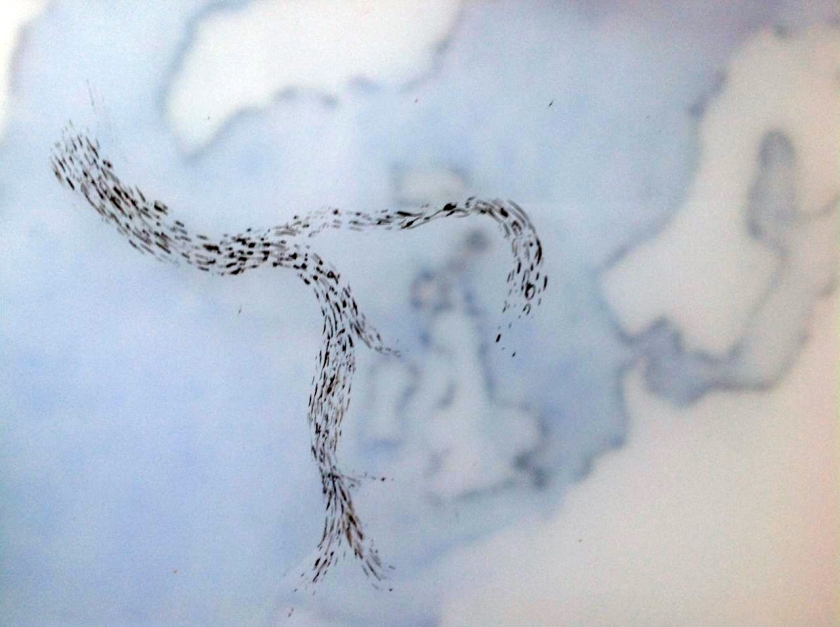In the burn, salmon eggs could be hatching just now. I learn that pimples on the fish’s skin become scales with marks that register their growth pattern, like tree rings. In actuality, these are in life tiny and transparent, but to understand them I draw them large and salmon coloured.
The Tweed Foundation collects scales from anglers, and accumulates data that helps interpret seasonal changes in the fishing catch. With a microscope, an expert eye might see that a salmon lived for two winters in the river, with a further winter at sea before returning to the Tweed to spawn. The wider separated bands in the blue drawing (a detail) suggest that this fish made a rapid transition to sea and began to feed well.
Sometime, there are checks in the usual pattern of faster summer growth, where the circuli stay tight and close.
Very rarely, a female salmon manages to return to sea after spawning, and runs upriver a second time. The Tweed is a long river, and perhaps only one in a hundred manage this. These fish have scales with spawning marks developing from interrupted growth where scales were consumed, reabsorbed for energy to swim upstream.
Typically a spawned salmon, a kelt, will die in the river and the eroded scales will document the exhaustion of the fish’s reserves.
Having learnt something of what can be seen close-up, I needed to take a step back to take this in. A textbook informs me how they deserve their name, ‘Atlantic Salmon’: they are a species who use ocean currents to drift to cold subarctic waters. Rich feeding to the west of Greenland allows them to mature before returning to their home river in mating mood.
Towards the end of this first lesson in scale-reading, our careful tutors say that there is currently speculation about future patterns that will be read in salmon scales. Within ten years perhaps, the north pole will be a navigable ocean, allowing passage to the Pacific.
To reflect on this, I look at recently published papers. With anxiety, I start to draw icebergs on perspex – dotting out the zone that was navigable to ice-hardy ships in 1970. In my drawing the icebergs lessen over time, and tail off at 2100. I wish it was the other way up, and I could draw them more concentrated at the pole, like this:
Scaling the Tweed started with a close-up view, but also is making me look further away.
Acknowledgements and thanks to Tweed Foundation. The text and drawings, and any errors, are my responsibility. This research drawing was undertaken as collaborative work with tabula rasa, in a project Working the Tweed, part of Year of Natural Scotland 2013.










Thanks. This is a really interesting piece making interesting connections both of and within the natural world, and man’s effects upon it.
LikeLike
Beautiful drawings! Had no idea that scale patterns could be read in this way, very illuminating.
LikeLike
Hi Kate,
I really very much enjoyed reading and looking at scaling the Tweed. Thank you. I did not know that one could read scales in the way you explained. Also I like your drawings very much. As usual your presentation is a very good match between text and the visual. I wish your scale-reading story could become available like your biography of a lie. It will be a matter of money of course. Keep me informed please love Hans
LikeLike